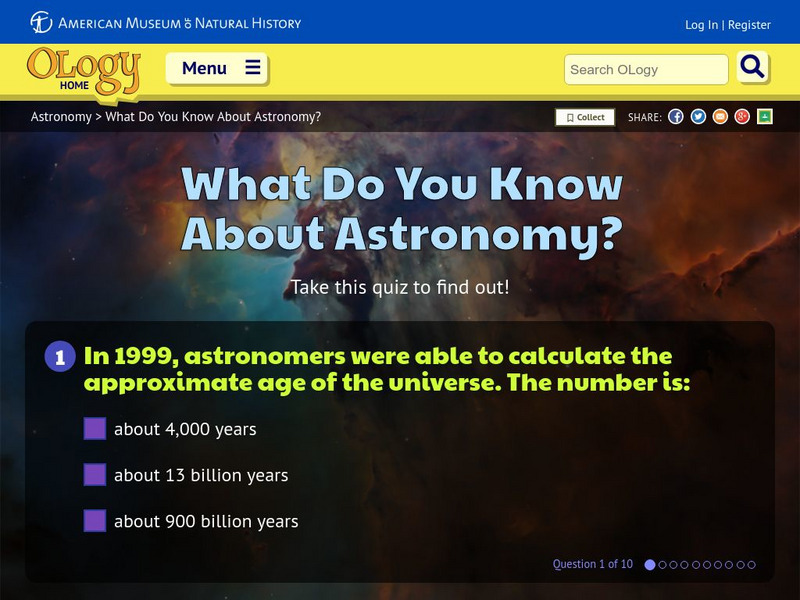Hi, what do you want to do?
Space Telescope Science Institute
Amazing Space: Comets: Comet Facts, Myths, and Legends
An interactive book full of interesting information about comets - their discovery, beliefs about them, factual information, and famous comets. An 'All about comets' link at the bottom of the page has lots of background information on...
Wikimedia
Wikipedia: Comet
A nice encyclopedia article from Wikipedia on comets describes what they are, their physical characteristics, gives a history of comet study, and provides a list of well-known comets.
Other
Killer Asteroid Project: Asteroids and Comets
Explains the differences between asteroids and comets. Presents a chart showing a size comparison between some known asteroids and comets.
Other
Welcome to David Levy's Home Page
This site chronicles the achievements of David Levy, one of the foremost individuals to discover the largest number of comets.
PBS
Pbs Learning Media: Our Solar System Lithograph Set
View these amazing high-quality images of our solar system from NASA with this lithograph set. Each lithograph contains images, facts, dates, and general information on a particular subject. Background information and teaching tips are...
Other
University of Leicester: Comets, Asteroids & Meteorites
Provides a general overview of comets, asteroids, and meteorites. Content includes ways to identify them in the night sky, as well as detailed information on each type of small body.
Other
University of Leicester: Comets
A detailed look at comets. Content outlines our observational history, as well as the origins of comets and an explanation of the appearance of comets.
Other
Cometography.com: C/1995 01 (Hale Bopp)
This site provides a detailed overview of the comet C/1995 01 (Hale-Bopp), the great comet of 1997. Content includes discovery, and observational and orbit information, as well as several images.
Smithsonian Institution
National Air and Space Museum: Exploring the Planets: Our Solar System
Take a tour of our solar system and learn fascinating details and observations about the planets.
BBC
Bbc Newsround: Top 5 Amazing Space Discoveries
Read about some of the most important space discoveries in recent times.
NASA
Nasa: The Space Place: Cosmic Car Crash
Get details about "Deep Impact", Nasa's mission to intercept Comet Tempel 1. The resource includes an animation of the route taken by their probe.
NASA
Nasa: The Space Place: What's in the Heart of a Comet?
NASA site explores what a comet's nucleus is composed of. Animation and photographs are provided as well.
NASA
Nasa: Stardust Educator's Guide
Features lots of projects for students to learn about space and space exploration.
NASA
Nasa: Comet Hale Bopp Images
This site contains 5,161 images of the Hale-Bopp comet from 1995 to 2000. This incredible photo archive is definitely worth a visit.
NASA
Nasa: Students K 4
NASA-sponsored coverage and research on a range of topics related to space exploration -- flying weather stations, comets, first steps on the Moon, and other space-related topics -- are presented in age-appropriate activities, lesson...
NASA
Nasa: Our Solar System Lithograph Set
View a lithograph set that includes pictures and brief descriptions of planets, sun, asteroids, comets, meteors, and meteorites. While viewing the lithograph learn important dates and interesting facts about our solar system.
PBS
Pbs Learning Media: Meteor Showers
This video segment adapted from NASA uses animation to illustrate the properties of meteor showers and comets. Included is are visualizations of a comet's tail and of Earth passing through a debris stream left behind by meteoroids.
NASA
Nasa: What Is a Planet?
This lesson teaches students about the characteristics of planets, comets, asteroids, and trans-Neptunian objects. After learning about these different things, students then are to debate about a new object that is found in space.
Cosmos 4 kids
Cosmos4 kids.com: Solar System Details
This comprehensive site delves into other aspects of our solar system besides the planets and the sun. Click on the topics on the right like solar winds, the heliosphere, the heliopause, asteroids, comets, and more.
Cosmos 4 kids
Cosmos4 Kids: Solar System Details: Asteroids
Learn about asteroids. What are they? What is their structure? Difference between asteroids and comets? The brief, to the point text makes this site most suitable for the younger researcher.
Cosmos 4 kids
Cosmos4 Kids: Solar System Details: Comets
All about comets! What are they? How do they occur? What are their effects in the solar system? The brief, easy to understand text make this site most suitable for the younger researcher.
NASA
Bumping Into a New Friend
On July 4, 2005 a probe collided with comet Tempel 1. This site is for younger children who would like to understand more about this comet or just comets in general. It's designed to look like a story book and is quite basic.
American Museum of Natural History
American Museum of Natural History: O Logy: What Do You Know? Astronomy
Take this ten-question self-scoring quiz to test your knowledge of astronomy facts: age of the universe, why stars and planets are spheres, where other life might exist in the outer space, the Milky Way, and more.
TED Talks
Ted: Ted Ed: Could Comets Be the Source of Life on Earth?
While comets were historically thought to be ill omens of war and famine, recent science has revealed that these celestial wonders actually contain amino acids, the building blocks of life on Earth. Justin Dowd explores the implications...






















